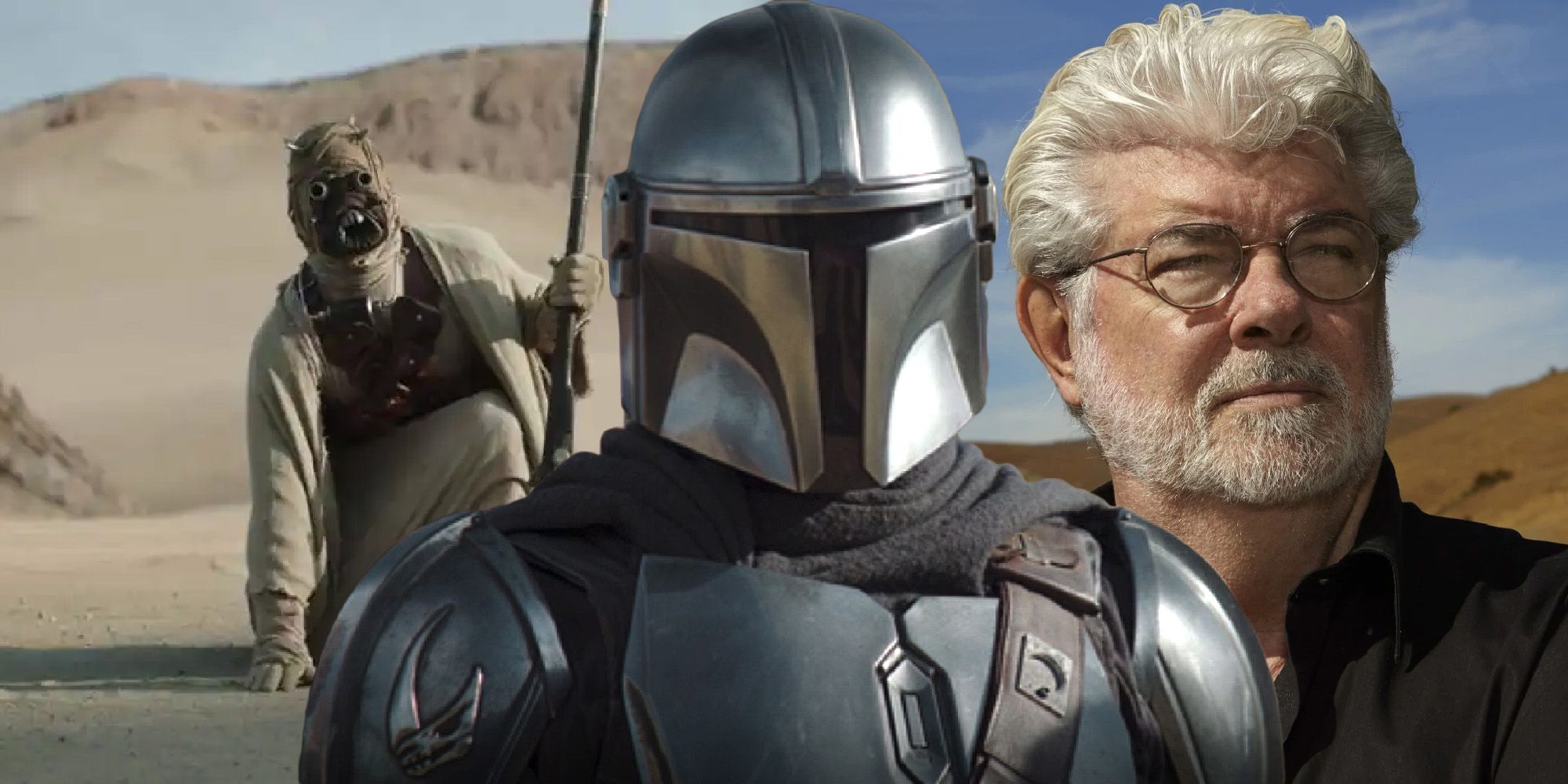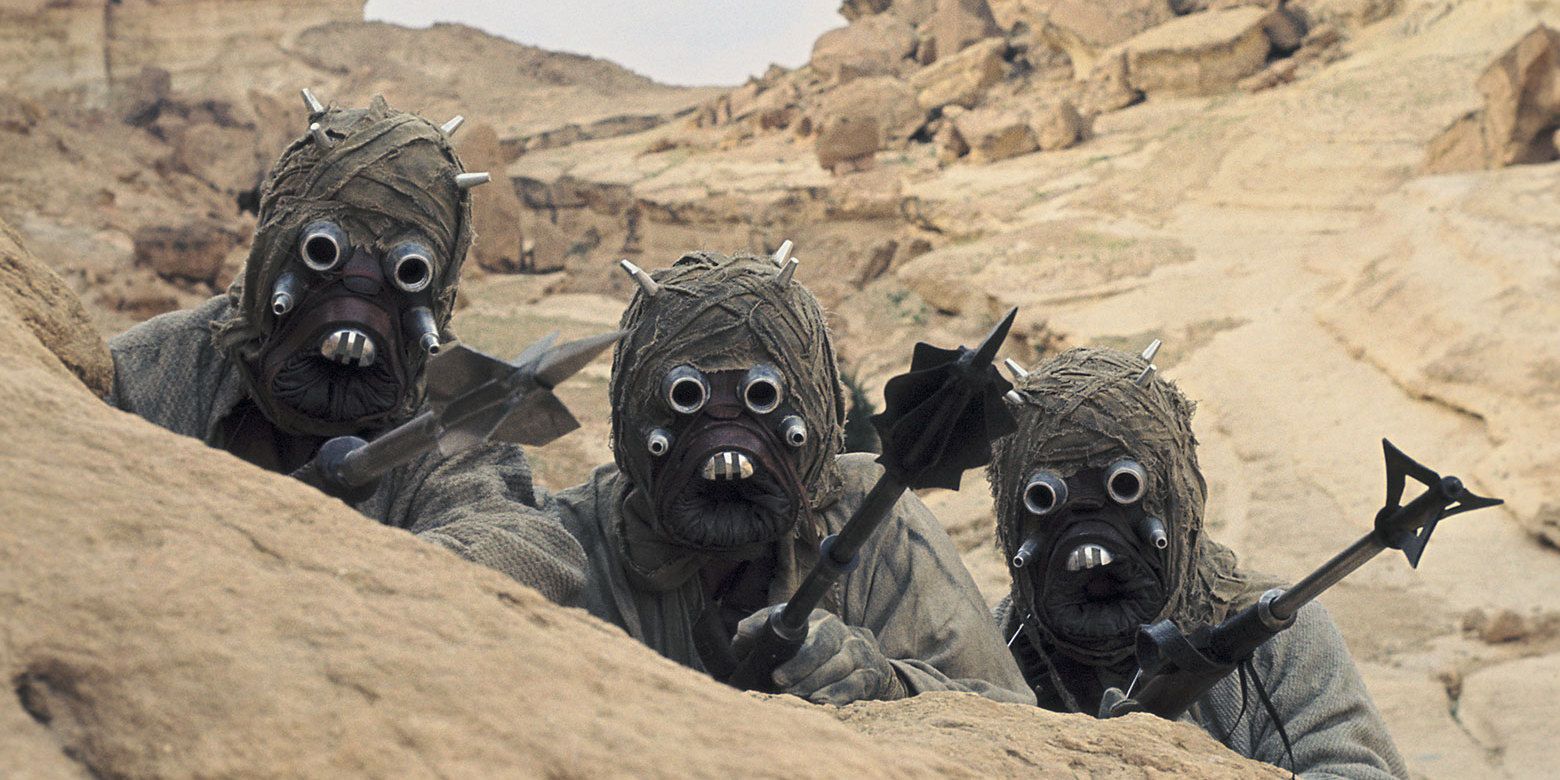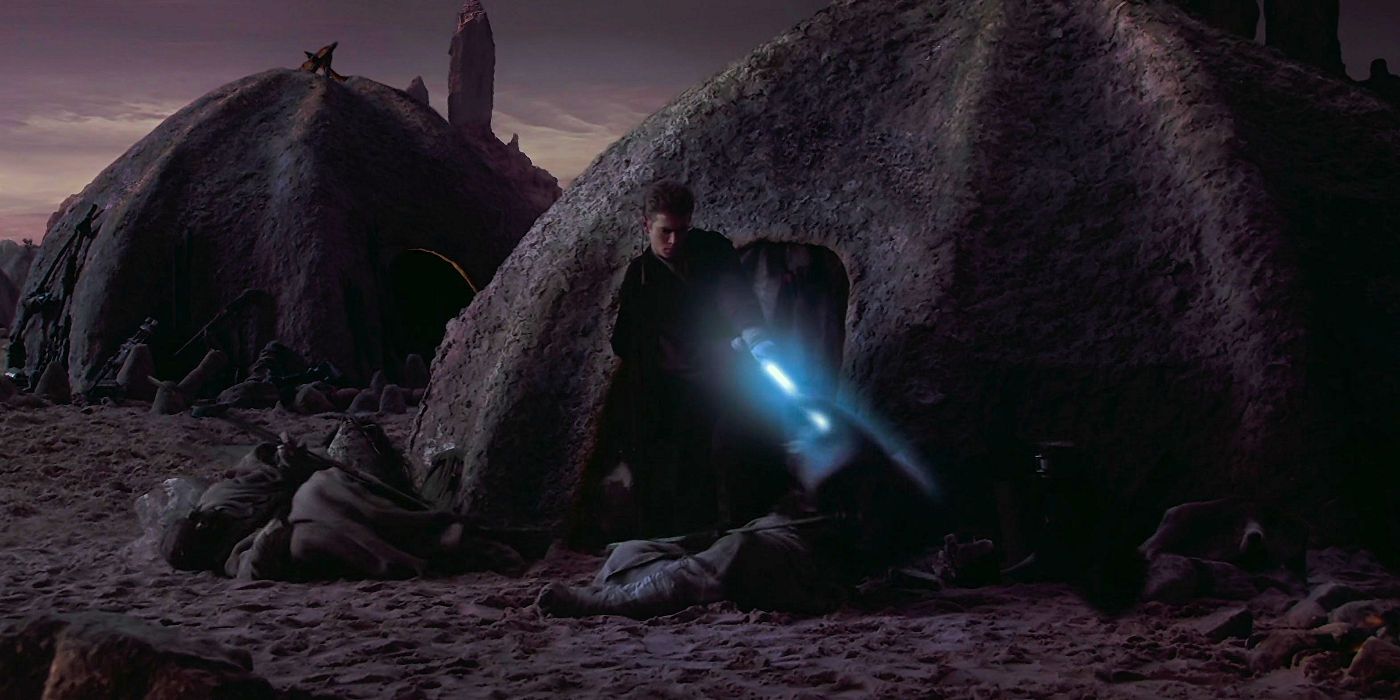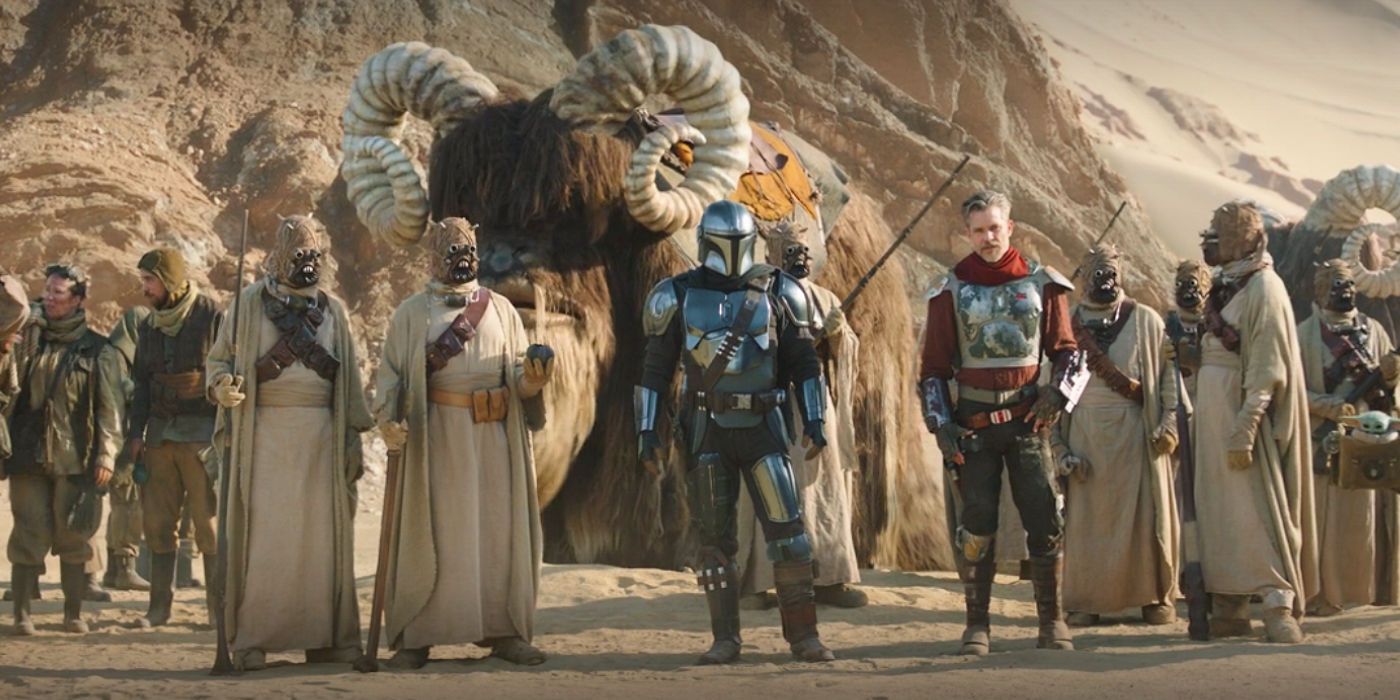
George Lucas' depiction of the Tusken Raiders (aka Sand People) in the original and prequel Star Wars trilogies was narrow-minded, but now The Mandalorian has fixed that mistake. Originally conceived as a one-off story (because sequels weren't so ubiquitous back then), Lucas presented a clear-cut storyline with his original Star Wars movie, one that didn't require expansion or further elaboration until he wanted to revisit that galaxy with sequels - and, eventually, prequels.
A good portion of A New Hope takes place on Tatooine where the film gets most of its exposition out of the way - learning about the Clone Wars, the Jedi, Luke Skywalker's father, and even how Imperial stormtroopers have superior accuracy - but it's also a location teeming with life and culture in certain areas, in spite of the world itself being a wasteland. In fact, the Tusken Raiders are among the first alien species viewers see in that movie, with Obi-Wan Kenobi briefly explaining that they're a violent species who move in single file to hide their numbers.
Much of what Lucas did with the Tusken Raiders in A New Hope carried over to the Star Wars prequels, particularly the beginning of Star Wars: Episode I - The Phantom Menace and the middle of Star Wars: Episode II - Attack of the Clones. Although they weren't around too much in the former, they played a small but significant role in the latter, ultimately being one of many reasons that led to Anakin Skywalker's downfall to the dark side of the Force. But if Star Wars portrayed the Tusken Raiders like The Mandalorian has, perhaps things would've turned out differently.

Star Wars' continued success more than four decades since the original movie released is owed to Lucas' wild imagination, but it's not like he spawned everything out of thin air. Lucas, like many filmmakers then and now, take inspiration from real-life people, cultures, and regions - and that's certainly applicable to the Tusken Raiders. Lucas has previously said that the Bedouin people of North Africa and the Middle East heavily influenced the design, culture, and history of the Tusken Raiders. And while it was great that Lucas sought to bring some attention to the Arab world, he went about it all wrong.
Lucas and Star Wars' depiction of the Tusken Raiders in the original and prequel Star Wars trilogies is quite degrading. The Tuskens are desert dwellers and they've somehow managed to live in the desert - particularly in the Jundland Wastes - for thousands of years without needing any sort of advanced technology to help them. Yet when they're introduced by Obi-Wan Kenobi in A New Hope, they're talked about like they're savages - in fact, the official Star Wars website still refers to them as "fearsome, desert savages" to this day - and they're quickly dismissed as Sand People.
A New Hope went to great lengths to show viewers that travelling outside of cities and inhabited areas is dangerous, not just because of animals roaming around out there but specifically because the Sand People would come and get them. Lucas' depiction of the Tusken Raiders made them out to be mindless barbarians who are incapable of even targeting a Jawa Sandcrawler. But that wasn't true, and unfortunately, that line of thought continued beyond the original trilogy and into the Star Wars prequels - this was especially noticeable in Attack of the Clones when Anakin Skywalker returned to his home with Padme Amidala.

Even though most of the galaxy changed in the prequel trilogy - with the planets in the Galactic Republic being shown as being beautiful places with robust societies (before the Clone Wars) - not much changed on Tatooine. As it turns out, Tatooine was always considered a backwater planet, with a crime-laden economy filled to the brim with slaves. That is, if anyone knew it existed, which the Jedi certainly did not at the time. Still, while slave owners like Watto were given free passes by the Jedi and were treated fairly by everyone else, the entire planet continued to see Tusken Raiders as lesser than.
Years after Anakin left Tatooine to be trained as a Jedi Padawan, he returned to find his mother who had taken by the Tusken Raiders. Because everyone thought they were violent people with little to no regard for human life, Owen Lars assumed Shmi Skywalker was dead - which was only partially true as she did die when Anakin later found her. Attack of the Clones needed a way to push Anakin towards the dark side, to begin his path towards becoming a Sith Lord under Palpatine, and having his mother die right before his eyes, thus making him powerless (which would later tie into his desperation to save Padme), was apparently the best option. But in doing so, Lucas demonized the Tusken Raiders.
Everything that was teased in A New Hope finally came to fruition in Attack of the Clones. The Tusken Raiders were just as violent as people said they were, and in order to provide Anakin with some sort of catharsis in the moment, Lucas had him slaughter the entire village - possibly even the women and children, if they were there. At least, at that point, audiences could start to feel bad for them. Yes, they captured and perhaps tortured Shmi, but Anakin potentially killed dozens of them. It's a weird area that Lucas wanted to play in, but despite the additional screen time, not much more nuance was applied to them. Why did the take Shmi? What were they planning on doing? How do they live out in the desert? Some of these questions still haven't been answered, but now, The Mandalorian has, on some level, humanized them.

The great thing about The Mandalorian is that it's diving deeper into established cultures and showing the average citizen's perspective on the Star Wars galaxy. There's so much that fans don't know about the New Republic era because all of it was sidelined to tell the First Order's story in the sequel trilogy. But The Mandalorian isn't beholden to that story or those characters, so it's able to elaborate on what happened across the galaxy after the second Death Star was destroyed. That's very much noticeable with Tatooine and the Tusken Raiders.
Through Din Djarin aka Mando, The Mandalorian season 1 subtly revealed that Tusken Raiders were people who could be bargained with. By using sign language, Mando successfully traded binoculars for passage through the Dune Sea. It was done so without any violence - the Tusken Raiders didn't attack Mando or Toro Calican, likely because they didn't feel threatened even though two bounty hunters were in their territory. While that was a brief moment in season 1, The Mandalorian season 2 expanded on it with more screentime and additional explanations on the Tusken Raiders and their way of life.
In fact, The Mandalorian season 2 makes the Tusken Raiders out to be a proper culture, one rooted in tradition. Obi-Wan once said that the Tusken Raiders always ride in single file in order to hide their numbers, and that happened in The Mandalorian season 2, episode 1, "The Marshal". Mando even spoke the Tusken Raiders' language enough to join forces with them to take out the krayt dragon. Cobb Vanth was ready to attack them because of prior history, but even knowing who the Marhsal was, the Tusken Raiders still invited him into their village and offered him water. They were willing to put aside their differences to achieve a common goal and establish a peace agreement. Furthermore, the Tusken Raiders were then shown to be an intelligent species. They had been studying the krayt dragon for generations and knew when it was sleeping, what it would eat, and how it would attack. The Tuskens even used a ballista weapon to harpoon the monster and draw it out in the open.
The Mandalorian season 2 went far in refining the Tusken Raiders' culture, so much so that calling them Sand People can now only be considered derogatory. By doing this, The Mandalorian did what Lucas could not: It turned the Tusken Raiders into real people, not xenophobic savages who wouldn't let anyone near them or accept anyone into their ranks. In many ways, The Mandalorian brought what the Expanded Universe did with the Tuskens - exploring their history, their humanity, and their perspective things - into Star Wars canon. It's easy to dismiss what the Expanded Universe/Legends did because those stories were always extra, but The Mandalorian grasped at the perfect opportunity to fix one of George Lucas' original mistakes with A New Hope.
from ScreenRant - Feed https://ift.tt/34Reyur

0 Comments